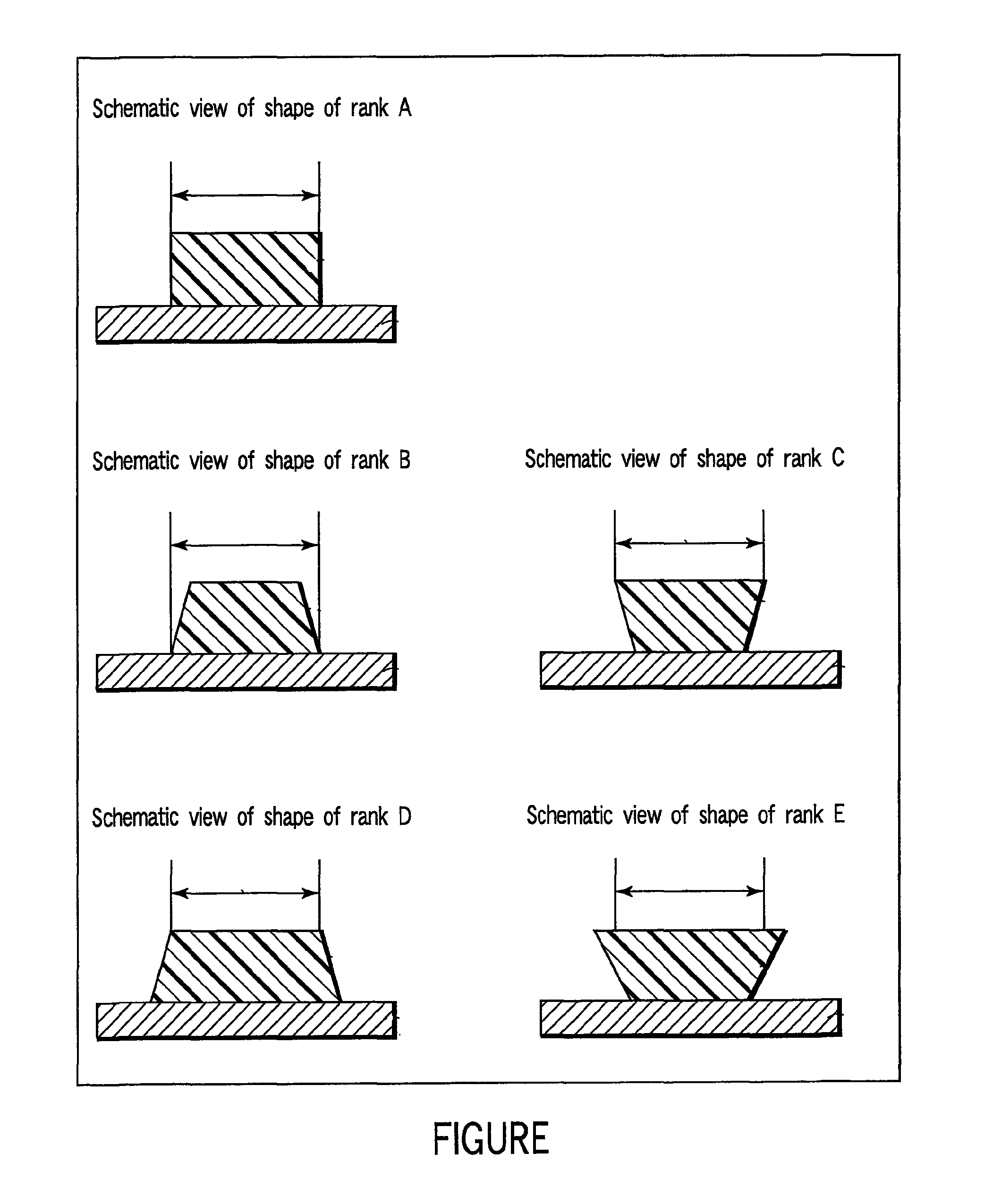Alkali development-type solder resist, cured product thereof, and printed wiring board prepared by using the same
a technology of alkali development and solder resist, which is applied in the direction of inks, thermal imaging, nuclear engineering, etc., can solve the problems of not meeting the requirements of form films, the application range of photopolymerizable compositions containing a conventional photopolymerization initiator is extremely limited, and the photopolymerization potential is high, and the effect of high hardenability
- Summary
- Abstract
- Description
- Claims
- Application Information
AI Technical Summary
Benefits of technology
Problems solved by technology
Method used
Image
Examples
example 2
Preparative Example 2
[0129]In a 2-liter separable flask equipped with a stirrer, a thermometer, a condenser tube and a dropping funnel, placed are 440 g (2.0 equivalences) of a cresol novolac-type epoxy resin (EOCN-104S manufactured by Nippon Kayaku Co., Ltd., softening point: 92° C., epoxy equivalence: 220) and 394 g of carbitol acetate, and the mixture was agitated under heat at 90° C. for solubilization. The mixture was then cooled to 80° C.; and 115.2 g (1.6 equivalences) of acrylic acid, 86.4 g (0.4 equivalence) of ε-caprolactone-modified acrylic acid manufactured by Toagosei Co., Ltd., 2.0 g of triphenylphosphine, and 0.8 g of methylhydroquinone were added thereto; and the mixture was reacted at 90 to 95° C. for 18 hours, to give a reaction product having an acid value of 1.8 mg-KOH / g. 273.6 g (1.8 equivalences) of tetrahydrophthalic anhydride was added thereto, and the mixture was reacted at 90° C. for 8 hours. 241.4 g (1.7 equivalences) of glycidyl methacrylate was added to ...
example 3
Preparative Example 3
[0131]In a 2-liter separable flask equipped with a stirrer, a thermometer, a condenser tube and a dropping funnel, placed are 440 g (2.0 equivalences) of a cresol novolac-type epoxy resin (EOCN-104S manufactured by Nippon Kayaku Co., Ltd., softening point: 92° C., epoxy equivalence: 220) and 310 g of carbitol acetate, and the mixture was agitated under heat at 90° C. for solubilization. The mixture was then cooled to 80° C.; and 86.4 g (1.2 equivalences) of acrylic acid, 172.8 g (0.8 equivalence) of ε-caprolactone-modified acrylic acid manufactured by Toagosei Co., Ltd., 3.0 g of triphenylphosphine, and 0.8 g of methylhydroquinone were added thereto; and the mixture was reacted at 90 to 95° C. for 18 hours, to give a reaction product having an acid value of 2.1 mg-KOH / g. 273.6 g (1.8 equivalences) of tetrahydrophthalic anhydride was added thereto, and the mixture was reacted at 90° C. for 8 hours. 127.8 g (0.8 equivalences) of glycidyl methacrylate was added to ...
example 1
Comparative Preparative Example 1
[0133]In a 2-liter separable flask equipped with a stirrer, a thermometer, a condenser tube and a dropping funnel, placed are 430 g (2.0 equivalences) of an O-cresol novolac-type epoxy resin (Epichlone N-680 manufactured by Dainippon Ink and Chemicals, Inc., epoxy equivalence: 215) and 200 g of carbitol acetate; and the mixture was agitated under heat at 90° C. for solubilization. The mixture was then cooled to 80° C.; 144 g (2.0 equivalences) of acrylic acid, 2.0 g of triphenylphosphine, and 0.8 g of methylhydroquinone were added thereto; the mixture was reacted at 90 to 95° C. for 16 hours, to give a reaction product having an acid value of 0.6 mg-KOH / g. 167.2 g (1.1 equivalences) of tetrahydrophthalic anhydride was added thereto, and the mixture was reacted at 90° C. for 8 hours. Finally, 200 g of an aromatic solvent Ipzole #150 manufactured by Idemitsu Kosan was added thereto for viscosity adjustment, and the mixture was mixed and agitated before...
PUM
| Property | Measurement | Unit |
|---|---|---|
| wavelength | aaaaa | aaaaa |
| wavelength | aaaaa | aaaaa |
| wavelength | aaaaa | aaaaa |
Abstract
Description
Claims
Application Information
 Login to View More
Login to View More - R&D
- Intellectual Property
- Life Sciences
- Materials
- Tech Scout
- Unparalleled Data Quality
- Higher Quality Content
- 60% Fewer Hallucinations
Browse by: Latest US Patents, China's latest patents, Technical Efficacy Thesaurus, Application Domain, Technology Topic, Popular Technical Reports.
© 2025 PatSnap. All rights reserved.Legal|Privacy policy|Modern Slavery Act Transparency Statement|Sitemap|About US| Contact US: help@patsnap.com



